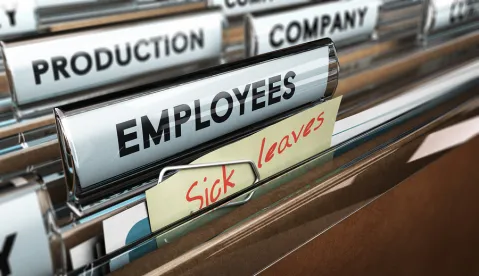One important question the Families First Coronavirus Response Act (“FFCRA”) and other recent legislative changes raise for employers is how to track and account for employee leaves. While most employers already have systems in place to track employee absences, employers should review their pre-pandemic recordkeeping to account for the “new normal” and new laws. These updates are not only to account for the FFCRA and any other federal or state laws – including the potential application for tax credits – but also, just as importantly, in anticipation of the return to work of the employer’s workforce.
This post provides practical guidance for employers on: (1) adjusting current systems to keep track of leave taken under the FFCRA; (2) documents to request from employees in connection with leave taken under the FFCRA; and (3) records that must be kept for leave taken under the FFCRA. While this guidance is focused on FFCRA leaves, it may also be generally applied to employee leave under any expanded state or local laws in connection with COVID-19.
Adjusting a Company’s Current System to Track Leaves
-
For companies with tracking systems in place (i.e. HRIS, Workday, etc.), those systems should be updated to account for the following:
-
Whether the leave is subject to a shelter-in-place or comparable order, including a mandatory or precautionary quarantine order, and the dates of those orders;
-
Dates the employee was absent;
-
The reason(s) for absence(s), with an indication if leave is being taken in connection with specific federal, state or local laws, including:
-
Amount of sick leave taken, and whether the sick leave qualifies for paid leave under the FFCRA, or any applicable state or local leave laws;
-
Whether the sick leave qualifies as a serious health condition as defined under the Family and Medical Leave Act (“FMLA”), or other applicable state or local laws;
-
Amount of leave taken in connection with caring for an employee’s son or daughter if their school or place of care has been closed, and whether the leave qualifies for paid leave under the FFCRA, or any applicable state or local leave laws;
-
Amount of leave taken in connection with caring for a family member, or other person who is subject to a quarantine or isolation order, and whether the leave qualifies for paid leave under the FFCRA, or any applicable state or local leave laws;
-
-
Whether an employee has the ability to telework during any leave period. Note that the Department of Labor (“DOL”) has recently issued guidance on what it means to be “able” to telework, as well as an employee’s ability to take intermittent leave under the FFCRA while teleworking;
-
Whether employee is in fact teleworking during any leave period or temporary office closures due to COVID-19;
-
For non-exempt employees that are teleworking, all hours worked while an employee is out of the office (with start and stop times, meal and rest breaks noted);
-
Whether an employee has elected to use any accrued sick or vacation time to supplement benefits provided under the FFCRA, or applicable state or local law; and
-
Whether any leave taken qualifies for short-term disability benefits.
-
-
Remember that tracking systems should not include employee medical information which, if maintained at all for legitimate reasons, must be kept separately from ordinary personnel information.
-
Companies lacking a tracking system should consider establishing one, not just to track leave taken in connection with COVID-19, but as a best practice to ensure compliance with applicable laws;
-
Companies required to provide leave under the FFCRA should also be sure to note on their payroll tracking systems any leave payments made under the FFCRA to ensure they will be eligible for prompt payroll credits for the cost of providing leave under the FFCRA.
-
Payroll should be tracking any paid leave provided to an employee, and noting whether an employee is receiving their regular rate of pay, or if the rate of pay is pursuant to FFCRA, or established state or local limits;
-
Normally, employers are required to withhold federal income taxes and an employee’s share of Social Security and Medicare taxes, and subsequently deposit these federal taxes with the IRS.
-
Under forthcoming IRS guidance, employers who pay qualifying sick or child care leave under the FFCRA will be able to retain an amount of the payroll taxes equal to the amount of qualifying sick or childcare leave, rather than deposit that amount with the IRS.
-
If there are not sufficient payroll taxes to cover the cost of leave paid, employers will be able to file a request for an accelerated payment from the IRS, which the IRS expects to process in two weeks or less.
-
-
What Documents Should a Company Request from their Employees in Connection with Leave?
-
Employees who wish to take FFCRA leave should provide their employers with documentation, as set forth below, to support that request. Additional guidance from the IRS is anticipated relating to tax credits available for such payments.
-
For leave taken under the FFCRA’s Emergency Paid Sick Leave Act, employers should request documentation illustrating the need for leave in connection with one of the six qualifying reasons. This documentation may include notices in connection with a federal, state, or local quarantine or isolation order; medical records from a healthcare provider; or notifications from a school or child-care provider regarding closures due to COVID-19. Some reasons will be easier to provide documentation for than others:
-
Leave taken in connection with a quarantine or isolation order, or leave taken in connection with an advisory from a health care provider to self-quarantine, will be easier to document than leave taken because the employee is experiencing symptoms of COVID-19 and seeking a medical diagnosis
-
Given the current difficulty in obtaining access to COVID-19 testing, or even medical care, employers should not deny an employee’s right to take leave simply because the employee cannot provide supporting documentation. As an initial step, employers should request that an employee provide an order of quarantine or isolation from his or her local health department. If the health department is unable to provide an order, the employee should submit documentation from a licensed medical provider that has treated the employee (or the employee’s child) attesting that the employee (or their child) qualify for the order. In the event the employee is also unable to provide that documentation, we recommend reserving the right to request the documentation, or requiring the employee provide it as soon as possible.
-
-
For leave under the FFCRA’s Emergency Family and Medical Leave Expansion Act, employers may request additional documentation as permitted under the certification rules for regular FMLA requests. This may include notices of closure or unavailability from a child’s school, or place of care.
-
Existing certification requirements under the FMLA remain in effect. As a result, an otherwise FMLA-eligible employee may request leave for a usual FMLA qualifying reason, i.e. the employee takes additional leave beyond the two weeks of Emergency Paid Sick Leave because his or her COVID-19 related medical condition has become a serious health condition (which leave of course is not required to be paid, but for which benefits must be maintained and a general right of restoration may exist).
What Records Should a Company Keep in Connection Leave Taken Under the FFCRA?
-
Retain copies of all documents provided by employees demonstrating the reason for leave. Although the FFCRA does not specify a required length of time for document retention, we would recommend maintaining documents for at least three (3) years, in line with record retention requirements for other wage related records;
-
Maintain adequate documentation regarding an employee’s leave that will enable the employer to track when an employee has exhausted his or her paid leave under the FFCRA, or state or local laws;
-
Maintain adequate documentation regarding an employee’s leave that will enable the employer to track when an employee has exhausted the employee’s accrued vacation or sick time;
-
Private employers required to provide leave under the FFCRA should also be sure to retain sufficient documentation that will permit them to claim a tax credit in connection with paid leave taken under the FFCRA;
-
Employers should familiarize themselves with the forms required by the Internal IRS in order to claim a tax credit. The IRS currently maintains a Coronavirus Tax Relief webpage, where it provides guidance for employers on obtaining tax credits under the FFCRA.
-
Taking additional recordkeeping steps now will ease the return to work of the workforce as well as the application for any tax credits that may be available. It will also allow employers better to navigate rapidly changing legislation. In the event an employer’s actions are subsequently challenged, or a claim is made that proper leave or pay was not provided, employers will have documentation in place to fall back on, which will mitigate the exposure of potentially costly claims.





 />i
/>i

